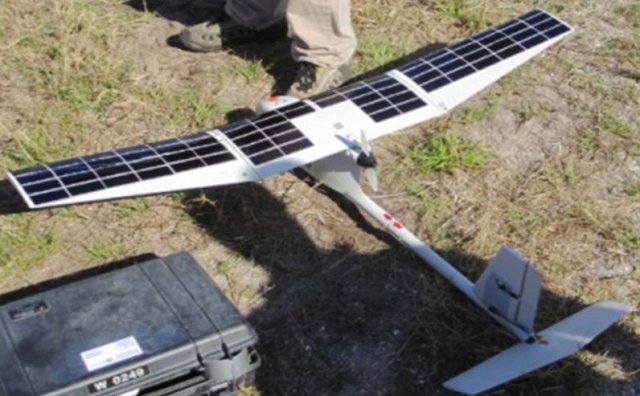 An Air Force Research Laboratory partnership with UES, Inc. and Microlink Devices, Inc., has integrated new lightweight, flexible, high-efficiency solar panels onto a small unmanned aircraft system (SUAS) platform.
An Air Force Research Laboratory partnership with UES, Inc. and Microlink Devices, Inc., has integrated new lightweight, flexible, high-efficiency solar panels onto a small unmanned aircraft system (SUAS) platform.
The additional power provided by solar cells to SUAS with electrically powered propulsion systems will increase UAS flight endurance and flight time, and will give special operations personnel with added field surveillance capabilities.
Researchers expect advanced solar cell technology to extend the potential daytime flight capability of a variety of small, hand-launched unmanned air vehicles currently used by special forces for situational awareness in combat areas. AFRL’s Materials and Manufacturing Directorate (RX), working with UES, Inc., the solar cell manufacturer Microlink Devices, Inc. and Designed Intelligence Incorporated, LLC, demonstrated this capability on the Raven platform. AFRL engineers developed three prototype Solar Raven UAS, which have demonstrated 60 percent increases in flight endurance, and show promise for a 100 percent improvement over those systems currently in use.
Current power and energy systems for SUAs limit mission time and are insufficient for autonomous operation. The challenge of meeting increasing power and energy needs is pervasive across the Air Force, particularly in the areas of portable power, deployable power, and autonomous sensor power technologies. Materials issues have limited the performance of both batteries and solar cells, and recent advances in materials processing by AFRL’s Space Vehicles Directorate and MicroLink Devices enabled the impressive gains demonstrated by RX on the solar-powered Raven.
To date, these solar cells have been successfully integrated onto the removable wing sections of the Raven, a small, hand-launched, remote-controlled aerial vehicle made by AeroVironment, Inc. It is powered by an electric motor, has a range up to 6.2 miles, and can reach speeds of 28 to 60 miles per hour. Currently, the Raven is powered by a lithium ion battery and has a flight time of approximately one hour. By using a power control module developed by AFRL’s Air Vehicles Directorate, RX integrated the cells with the existing power system and provided maximum power point tracking and power conditioning for augmentation of the battery.
The solar cells, 20 square centimeters in size, adhere to the wings of the vehicle using a clear, protective plastic film and an adhesive. The number of solar cells integrated onto wing – and the amount of solar power provided to the SUAS – depends on the surface area of the wings. The total improvement in flight endurance will also be related to the aircraft’s energy usage, but endurance increases near 300 percent are expected for some systems. AFRL has begun conducting solar cell integration work on the Puma and Wasp platforms. Further improvements in panel integration will be performed, with specific goals of improving the durability of the solar panels and reducing their weight. Future efforts will likely focus on manufacturing process improvements to enable the scale-up and transition of the technology.
Photo: The Solar Raven, equipped with solar cell technology – Credit: AFRL
Source: Wright-Patterson Air Force Base

Why not develop a Thermal sniffing location system to use hot rising air to supplement or even provide 100% of the lift to keep the drone in the air.
Glider pilots have been successful keeping their aircraft in the air without any external power at all by using the rising air provided by thermals when they exist which is most of the time on sunny days.